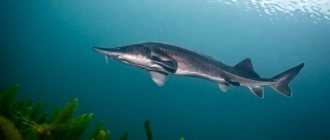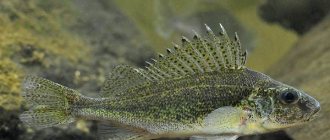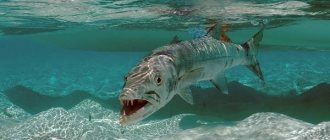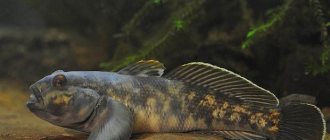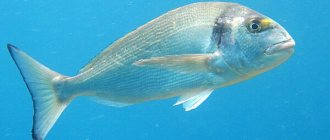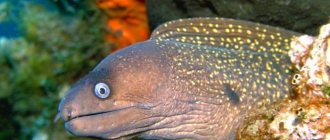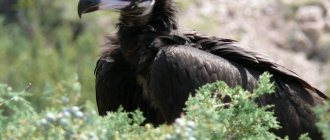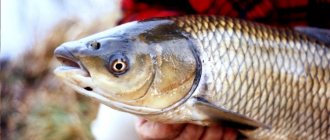Pike perch is a medium-sized fish from the perch family. With its elongated body shape it is similar to a pike, with transverse stripes on the sides it resembles a perch, it has two fangs on the lower and upper jaws, for which it received the nickname fanged from fishermen. Pike perch is one of the most popular fish among anglers who fish with spinning, trolling or live bait. Pike perch meat is considered dietary due to its high protein content and low fat content. A wide variety of dishes are prepared from pike perch, the most famous of which is pike perch aspic. Let's tell you more about this fish.
Appearance
Body of pike perch
Pike perch has a slender, slender, elongated body with slightly compressed sides, which is covered with small and hard scales that reliably protect the pike perch’s body from all kinds of injuries and the teeth of other predators.
The length of the pike perch's head is greater than or equal to the body height. The pike perch has an elongated, pointed, conical snout. The mouth is terminal and large.
The gill covers consist of three pairs: the operculum, the interoperculum and the preoperculum. This arrangement of gill covers provides pike perch with a reliable system for opening and closing gill slits.gill slits. approximately 20 elastic rays. A film with dark specks is stretched between the rays of the dorsal fin. When expanded, the dorsal fin of a pike perch resembles the dorsal fin of a perch, and is not inferior to it in terms of rigidity.
The caudal fin of the pike perch is symmetrical with powerful blades; the size and power of the caudal fin allow the pike perch to develop high speed.
On the lower part of the pike perch's body there are paired pectoral and ventral fins, and under the pike perch's tail there is an anal fin. All these fins have sharp spines that reliably protect the pike perch from enemies. The color of the fins is gray with a dirty yellowish tint.
Digestive system
The entire digestive system of pike perch is designed for a predatory lifestyle. The pike perch swallows its prey whole. The pharynx, esophagus and stomach of pike perch are very strong, extensible and elastic. All organs of the pike perch are compactly located in the upper part of the body, closer to the head, while the abdominal region remains virtually free. When a pike perch swallows its prey, the stomach stretches, occupying the previously free space in the abdominal part of the body. Having swallowed the prey, the pike perch waits until it is completely digested, only after that it resumes its hunt.
Body coloring
The body color of pike perch living in different bodies of water varies significantly. Typically, pike perch has a grayish-olive body color, with 8-12 dark brown stripes on the sides and a grayish-white belly with a faint yellow tint. The gill covers and sides of pike perch may have a golden hue.
Pike perch are often found with light-colored scales of a straw-yellow hue, with very faint pale brown stripes that look more like spots than stripes.
In deep bodies of water, with cold water, a dark bottom and a lack of sunlight, pike perch of darker colors are found. The back of such pike perch is almost uniformly black, the sides are dark brown, on which dark stripes are barely visible.
Vision, sense organs
Vision is the main system of perception of the surrounding world for pike perch. The eyes of pike perch are large, round, convex, with a brown iris. The eyes of pike perch are adapted to perfectly see their surroundings at dusk and at night. In addition to the highly photosensitivity photoreceptor cells of the retina, the eyes of pike perch have a special vascular layer - the tapetum, which is located behind the retina and consists of flat cells filled with guanine, an organic substance that reflects light.
Rays of light passing through the retina are reflected from the tapetum cells, as if from a mirror, and again enter the retina, re-stimulating the photoreceptor cells of the retina.
This device for the pike perch’s vision increases its sensitivity, allowing the pike perch to see in low light conditions; in addition, thanks to the tapetum, the pike perch’s eyes glow in the dark. Thanks to its vision, pike perch sees well in the dark, but does not like bright sunlight and does not distinguish colors well.
An important sensory organ for pike perch is the lateral line organ, which allows pike perch to catch the slightest vibrations in the water and accurately determine the distance and direction from the source of these vibrations. The lateral line begins in pike perch from the gill covers and runs throughout the body, right up to the tail; it is a canal with sensitive cells, which is connected to the outside world by small holes. The importance of the lateral line for pike perch is evidenced by the fact that a pike perch that has completely lost vision is able to survive by relying only on the information it receives from the lateral line.
Pike perch has a well-developed sense of smell. In the front of the head, under each of the eyes, the pike perch has two openings, these are the nostrils, from which there are passages to the internal organs of smell.
Pike perch has good hearing; it is able to clearly hear sounds heard on the shore of a reservoir, for example, human steps. Sound is transmitted through the bones of the skull to the right and left auditory sensors.
Pike perch, like other fish, has an organ of taste, the sensitive cells of which are located in the mouth of the pike perch, and organs of touch, the sensitive cells of which are located throughout the body of the fish.
Mouth, fangs and teeth of pike perch
Pike perch has a large mouth; when open, it resembles a pike in its width and toothiness. There are two fangs on the upper and lower jaws of the pike perch. Of the perch family, only two species have fangs - pike perch and Chinese perch (auha).
The size of the fangs of a male pike perch is larger than that of a female, which is a distinctive sexual characteristic. Between and behind the fangs are small, sharp, conical teeth. The entire structure of the pike perch's maxillodental apparatus is designed to capture and hold prey.
Common pike perch
Five related species of walleye
Common pike perch is a species of predatory fish from the genus pike perch, which belongs to the perch family. The genus of pike perch has five species; common S., Volga S., Canadian S., sea S. and lightfin S..
There are three species in Russia:
- Common C. - lives in fresh waters of the European part of Russia and East Asia, found in rivers and reservoirs of the Caspian, Black, Azov, Baltic and Aral seas.
- Volzhsky S. (bersh) is a smaller copy of the common pike perch, a small fish reaching a length of 45 -50 cm and weighing no more than 2.3 kg. Recently, it has become one of the rare species prohibited from catching in Russia. Found in rivers of the Caspian, Black and Azov seas.
- Sea S. is a small predator no more than fifty centimeters long and two kilograms in weight. Lives in the Caspian Sea and the western part of the Black Sea, does not enter desalinated waters.
Let's dwell on the common pike perch - a fish that inhabits our freshwater bodies of water and is of interest to fishermen not only for its large size and valuable gastronomic and dietary qualities, but also as an object for year-round fishing.
- Do you want to go fishing, but don’t know where to start, what gear to choose, where and how to fish?
The e-book “Fishing for Beginners” will answer all your questions and will be the best assistant in mastering this activity. More details
Pike perch is a desirable catch for every angler. Its lean and healthy white meat is highly valued by nutritionists and gourmets - lovers of delicious food.
Color, size and lifespan of pike perch
The common S. is considered one of the largest fish among perches. It grows up to 1.4 m, reaching 15-18 kg of weight. Under normal living conditions, it can live 14-15 years.
Sexual maturity occurs in the fourth year of life, in females several months earlier; in the north of the country, S. maturation is delayed by 1.5-2 years.
The body of the common pike perch is slender, elongated, densely covered with small and hard scales, which protect the fish from injury and the teeth of other predators.
The coloring of all adult fish is not the same; it depends on the geographical location of the reservoir and some other factors. The grayish-olive color with dark brown stripes located on the sides is considered classic and is characteristic of most populations. The number of stripes is dictated by the size of the S., there are 8-12 pieces. The sides and gill covers of fanged beauties are cast in a brass color.
Light-colored scales are very common, usually straw-yellow with faint pale brown stripes, more like spots, clearly visible only near the back.
Great depth, a dark bottom, and a lack of sunlight contribute to the darkening of the color of aquatic inhabitants. In deep, cold-water bodies of water, relict predators with dark decor are found. They have an almost monochromatic black back, flowing into a monochrome brown color on the sides, hiding rows of camouflage spots. The only bright spot in the gloomy attire of these animals is the grayish-white belly with a faint yellowness.
The special organ of vision of pike perch
The large eyes of a predator that came from the distant Oligocene, adapted to see at dusk and at night. In addition to the light-sensitive photoreceptor cells of the retina, nature has endowed the visual organ of the pike perch with a special vascular layer - the tapetum, consisting of flat cells filled with microscopic crystals of guanine - an organic compound that reflects light.
Located on the back of the eye, the tapetum serves as a mirror that returns light rays passing through the retina back to its surface, thereby re-stimulating the visual receptors. This effect increases the sensitivity of vision, allowing you to see well in low light conditions, and also causes the eyes to glow in the dark.
This is why our gluttonous character sees very well at night, but is forced to avoid bright light and has difficulty distinguishing colors. S.'s eyes, which glow in the dark, confirm the presence of a reflective layer in them, and their bulging eyes emphasize that the owner of the mirror gift tends to stay at great depths.
Fish fins and jaws
The pike perch has two high dorsal fins covered, like beads, with black dots. The first is spiky, consisting entirely of a palisade of bone needles, the second is softer, the number of needles in it is limited to 2-3 pieces. In each of the pectoral and anal fins, there are the same number of spines that protect the fish from enemies, of which it has very few, except for people.
The snout of the predator is elongated, the mouth is terminal, medium in size, there are fangs on the jaws, with which the pike perch grabs and holds the prey. Of the perch fish, only it and the auha, the Chinese perch, have such weapons; the other representatives of this family make do with bristly teeth.
Moreover, the size of the fangs of males is much larger than that of females; this fact is one of the distinctive sexual characteristics. In addition to fangs, the jaws of the ancient ichthyophage are equipped with small but sharp teeth.
Two forms of pike perch. Becoming a Predator
Ichthyologists conditionally divide the common S. into two forms: marine - semi-anadromous and sedentary - river, although they have no external differences. The semi-anadromous subspecies lives in river mouths and in desalinated areas of the seas, only rising to the upper reaches to spawn. The sedentary form lives and reproduces in one body of water. Pike perch fry begin to prey two months after birth, and until then their main food is small crustaceans. In warm regions, they hunt for 20-30 days, eating the fry of weakened fish, including their fellows.
Pike perch, like many other species of predatory and even peaceful fish, are characterized by cannibalism, which is not considered savagery in the underwater world. As they grow older, their predatory tendencies become more and more pronounced, and the number of small fish in their daily diet gradually increases. Over time, live fish makes up 80-90% of the food it eats, and pike perch becomes a typical predator, and a very voracious one at that.
In terms of insatiability, it can only compete with pike, with which they peacefully coexist in the same body of water, rarely intersecting with each other. Pike hunts during daylight hours in the middle and upper horizons, and the night hunter spends most of his time at the bottom or close to it.
Age and size of pike perch
Pike perch is the largest fish in the perch family. In favorable conditions, pike perch can grow up to 140 cm in length, reaching a weight of 15-18 kg. The maximum lifespan of pike perch is 14-15 years. But fish of this size are extremely rare; pike perch weighing 4 kg or more is already considered a very good trophy.
You may be interested in: Fishing in the Moscow region
Life cycle of pike perch
Puberty of pike perch occurs at 3-5 years of age. A mating union includes one female and several males, with only one of them having the right to mate. Subsequently, this male guards the eggs until the small fish are born. Young animals gain weight very quickly and even at a young age can consume the same juveniles of other fish species. The size of pike perch fangs is one of the distinguishing features of the sexual difference between females and males. Males have larger fangs. Pike-perch have a high life expectancy, sometimes their cycle reaches 15 years.
Relatives of zander
The marine form of walleye, the ancestor of modern walleye, arose during the Oligocene period, 34 to 24 million years ago.
The first freshwater pike perch appeared in Siberia during the Pliocene era, from 5.3 to 3 million years ago. Fossils found by scientists indicate that over the past 3 million years, pike perch has practically not changed its appearance compared to its ancestral form.
Pike perch is part of the perch family, which also includes such well-known fish as perch and ruffe. In the perch family, pike perch is included in the separate genus Sudaki.
The genus Sudaki includes 5 biological species:
- The common pike perch is the most widespread and best known species. The scientific Latin name for this species is Sander lucioperca.
- Light-finned (yellow) pike perch - got its name for the light color of its fins. The scientific Latin name for this species is Sander vitreus.
- The Canadian walleye is a North American species of walleye found in the St. Lawrence River, its tributaries and lakes included in this river system. The scientific Latin name for this species is Sander canadensis.
- Sea pike perch is the only species among pike perch that constantly lives in salty sea water, and not in freshwater bodies. Lives in the Caspian Sea and coastal areas of the western part of the Black Sea, does not enter fresh waters. Sea pike perch is a relatively small fish, reaching a maximum length of 50 cm and a maximum weight of 2 kg. The scientific Latin name for this species is Sander marinus.
- The Volga pike perch (bersh) is a smaller copy of the common pike perch, reaching a maximum length of 45-50 cm and a maximum weight of 2-2.5 kg. Found in rivers of the Black, Caspian and Azov seas. In appearance it is very similar to the common pike perch, but unlike it, it has darker and more clearly defined stripes, the bersh has no fangs, the bersh's head is shorter and wider, and the bersh has larger scales. The scientific Latin name of this species is Sander olgensis.
What is the difference between bersh and pike perch?
Pike-perch, bersh and perch
Pike-perch are sometimes confused with relatives belonging to the same family. The bersh, or Volga pike perch, has the greatest external similarity to the common pike perch. Beginning fishermen often do not distinguish between these related fish breeds, mistaking the bersh for a young zander. At first glance, both types look almost the same, but upon closer inspection you can see the difference between them:
- The head of the Volga pike perch is shorter and wider, the eyes are larger.
- It has larger scales that cover not only the body, but also part of the gill covers.
- The teeth on both jaws are almost the same length.
- The dorsal fins of the bersha are higher with rounded edges.
PERCH
Spreading
Pike perch is common in medium and large rivers of Eurasia. Pike perch is found in the rivers of the Black, Caspian, Azov, and Baltic seas. In Western Europe, pike perch can be found in all major European rivers. North of 64 degrees north latitude, pike perch are rare. Most pike perch are found in large rivers: the Volga, Ural, Don, Oka. Pike perch are often found in lakes and large reservoirs.
Artificial breeding of pike perch
Since pike perch is a predatory fish, its artificial breeding in open waters is possible only as an auxiliary species, while the main object of breeding should be another “herbivorous” fish, for example, carp or silver carp. In this case, the pike perch will perform the functions of an orderly, destroying weed and diseased fish, that is, maintaining the health of the main population.
It is also important to note that only freshwater pike perch fish can be bred, because in any case it will not be possible to breed sea pike perch, which require salt water, in a pond.
Otherwise, pike perch is very suitable for farm breeding. This fish grows quite quickly and gains quite a significant weight. In addition, it is relatively resistant to all kinds of diseases, and therefore does not cause unnecessary trouble.
Pike perch habitats
Pike perch loves large expanses of water and is very demanding about the purity and amount of oxygen in the water, therefore it avoids reservoirs with stagnant water where there is no current. The main condition for the existence of pike perch in a reservoir is the presence of clean running water; in those reservoirs where there is no running water and there are no springs or springs flowing into the reservoir, there will be no pike perch.
Pike perch prefers to live in large and deep rivers, choosing places with a rocky, gristly or sandy bottom. In rivers, pike perch prefers to stick to deep places: holes, whirlpools, steep yars. Pike perch likes to stay in places where the depth changes sharply, on the so-called depth drops, on channel and near edges. Pike perch likes to stay in snags, among fallen trees and bushes.
Small pike perch often stand in shallow places. To hunt, pike perch go out to shallow sections of the river, sand spits, in the evening and in the morning, where they hunt for small fish.
Pike perch can live not only in rivers, but also in large and deep lakes and reservoirs with running water. Here it also sticks to the deepest places, areas of the flooded river bed, former ravines, deep holes and areas littered with snags.
In both rivers and reservoirs, pike perch likes to hide in unnatural shelters formed at the bottom of the reservoir; these can be sunken boats, reinforced concrete piles, collapsed bridge structures or railroad sleepers.
How to clean and cut
Many housewives do not like to clean and cut up pike perch, because its scales, like those of a perch, are small, hard, and dense. But the taste and benefits of the prepared dishes prove that the effort is worth it.
To clean fish from scales, use a sharp knife, a special fish scaler, a grater or a spoon. You will have to try to remove the scaly cover of the fish, and show ingenuity by protecting the kitchen from scales flying in all directions. To do this, you can use several tricks:
- Pour some water into the sink and place the fish in it: the liquid will prevent the scales from flying off.
- Place the fish in a large plastic bag and do the procedure inside it.
- Place in the freezer for an hour: frozen fish cleans faster and easier.
- Another quick cleaning method is to first pour boiling water over the fish.
Cutting pike perch at home does not require any special skills and is carried out traditionally:
- Cut off the spines on the gills and fins.
- Rub with salt so the fish will not slip.
- Remove scales.
- If necessary, remove and separate the skin by pulling it back and helping yourself with a knife.
- Rip open the belly and carefully remove the entrails, being careful not to touch the gall bladder.
Then it all depends on how the fish is prepared. Maybe a whole carcass will be cooked. Or it can be cut into steaks about 2 centimeters wide, for example, for frying or steaming.
To properly cook fillets, you need to separate the layers of meat from the bones. You need to cut the flesh along the back to the ridge and easily cut it off the rib bones. Remove the remaining seeds with tweezers.
This processing will take a maximum of half an hour, and the pike perch will be fully prepared for cooking according to the chosen recipe.
Baked pike perch
Sedentary and semi-anadromous pike perch
The common pike perch is a freshwater fish, but exists in two forms: residential-river-sedentary and sea-semi-anadromous.
The resident form of pike perch spends its entire life in the river, and this is where it reproduces.
The marine semi-anadromous form of pike perch spends the main part of its life in the sea, most often in the slightly salty part of the Azov or Caspian Seas. Here pike perch feed on sprat, gobies and sabrefish. Due to the abundance and variety of prey caught by pike perch in the sea, semi-anadromous pike perch grow faster and are usually much larger than sedentary pike perch. At the time of spawning, in March-April, semi-anadromous pike perch enters the rivers and rises upstream. Most often, semi-anadromous pike perch spawn at a short distance from the sea. After the end of spawning, in April-May, semi-anadromous pike perch returns to the lower reaches of the river, to desalinated areas of the seas.
Bersh and pike perch - differences
Both fish belong to the same genus and family. However, they are slightly different from each other:
- The teeth of the pike perch are larger than those of the bersh, and fangs are clearly visible in the jaw of the former, which is not the case in the latter.
- The gills of the bersh are covered with small pearlescent scales; in pike perch, this part of the head is smooth.
- The pike perch's mouth is much larger.
- The bersha stripes on the back are brighter and more pronounced.
- There is a difference in the size of the fin, the pike perch has a much larger one, and it has spines.
Bersh
Zander lifestyle
Pike perch prefers to lead a gregarious lifestyle. Small pike perch live in large schools. Pike-perch weighing 800-900 grams live in schools of 10-30 fish. Larger pike perch stay in even smaller schools. The rule almost always applies: the larger the pike perch, the smaller the school. The largest pike perch stay and hunt alone.
In late autumn, pike perch migrate to great depths of up to 10-12 meters for wintering, gathering in large schools for this purpose. The time for pike perch to gather in large schools coincides with the yellowing of birch leaves. At the head of the school are the largest individuals, and the school is closed by the smallest pike perch, wintering for the first time. Winter stops for pike perch are the deepest parts of the reservoir. The school stays together until spawning, then breaks up into separate schools and groups.
Pike perch is most active in the evening and at night, preferring to stay in deep places in the reservoir during the day. During the daytime, pike perch is mainly at rest.
You may be interested in: Twister
Pike perch and pike often coexist in the same body of water, while rarely intersecting with each other. Pike hunts during daylight hours, most often at mid-water or near the surface, while pike perch hunts mainly at night and most often near the bottom.
Pike perch food
The diet of pike perch consists only of animal feed. These predators are also characterized by cannibalism, which is not something immoral. Juveniles feed on leeches, worms and other invertebrates. Large pike perch prefer larger living creatures: river crustaceans, frogs, and representatives of other species of peaceful fish. When searching for food, the predator follows the same proven routes, and in strong currents it can wait for a potential prey, hiding in a shelter. Its color camouflages well. The zander fish blends into the local landscape, which contributes to a sudden attack. The structure of the head does not allow swallowing large prey; therefore, the predator is forced to consume small representatives of the underwater environment.
What does pike perch eat?
Pike perch is a typical predator. The newly hatched pike perch larva feeds on zooplankton: diaptomus and cyclops, insect larvae and bottom invertebrates.
Having reached a size of 20-30 mm, pike perch begins to feed on larvae and the smallest fry of other fish.
Pike perch that have grown to 500 grams feed mainly on small fish. Adult pike perch of any size, up to trophy specimens, prefer to feed on small, narrow-shaped fish, 8-9 cm long. Pike perch mainly feed on: bleak, minnows, gobies, small roach, and sprat.
Residential and semi-anadromous forms of pike perch have the same diet, but pike perch living at the confluence of rivers into the sea have a greater choice of food and their prey is usually larger, so semi-anadromous pike perch grow much faster.
After the pike perch has caught and swallowed its prey, it stands in a shelter, near a stone or snag and waits until the prey it has swallowed is digested, only after which it resumes its hunt. The pike perch is very careful in swallowing its prey, because prey that is not sized or swallowed incorrectly can get stuck in its narrow throat.
An adult pike perch is more voracious than even pike and perch; in favorable conditions it can grow in 2 years to a weight of 1 kg. To increase weight by 1 kg, pike perch must eat about 3.3 kg of fish.
The origin of pike perch - an excursion into the past
When eating a delicious fish dish of pike perch, many do not imagine that they are eating fish that has lived on Earth for 25 million years, of which the last five million years have existed unchanged. The ancestral - marine form of pike perch, which gave rise to the freshwater species, arose in the Oligocene era (34-24 million years ago).
DNA analyzes of fossil finds of ancient forms of ray-finned fish confirm that the real freshwater pike perch appeared during the Pliocene period, which began 5.3 million years ago. n. and lasted almost 3 million years.
The homeland of freshwater pike perch is Siberia. So freshwater pike perch ( further in the text there are abbreviations for the word “S” ) can rightfully be considered a truly Russian fish of Siberian origin.
The fossils found confirm that evolution over such a long period of time did not affect our character, leaving his appearance unchanged, but radically influenced his places. Freshwater and saltwater pike perch have spread throughout the world.
How to hunt pike perch
Pike perch is a typical predator; its diet consists of small fish of various species. Pike perch uses two different methods in hunting prey: from ambush and from hijacking.
When hunting from an ambush, the pike perch takes cover behind some uneven bottom, snag or stone lying on the bottom, waiting for its prey until it is within throwing distance of it.
When hunting for stealth, pike perch patrols its grounds, moving along edges and steep slopes into the depths, from one shelter to another. As soon as the pike perch encounters prey on its way, it quickly attacks it with a swift throw.
Chasing a bleak or some other fish, the pike perch, in the excitement of the chase, jumps out onto a shallow place or even onto a sandy shore. After floundering, the pike perch rolls back into the water, but it happens that it doesn’t succeed and then it either falls into the hands of a person or simply dies on the shore.
At night, pike perch go to shallow waters to hunt, organizing a so-called “fight”, with characteristic pike-perch splashes. The pike-perch “fight” differs from the “fight” of other predatory fish. The pike-perch “fight” begins as if on command, the pike perch begin to chase the bleak across the entire surface of the river or lake, the pike-perch “fight” usually lasts 20-30 minutes. The sound of a pike perch splash during a “fight” is similar to the sound of a stone thrown into the water. During the “fight,” the pike perch does not take any bait, but as soon as the fight ends, the pike perch begins to be caught.
Pike perch dishes
The entire species diversity of predatory pike perch is represented by fish with a low bone content. This makes it an attractive product for preparing pike perch dishes. If you can’t catch fish, then it’s definitely worth buying and trying. There are some recommendations for choosing a fresh specimen. First, you need to check the fish for smell. She shouldn't have it. Secondly, we evaluate the appearance and look for the presence of cuts and cracks in which infectious bacteria can develop. The fish must be whole and without any damage. We examine the eyes of the pike perch for transparency. The presence of inclusions and white veil is not desirable. Yellowness on the belly of the fish may indicate periodic freeze-thaw cycles. Most likely, such a copy is already reaching the end of its shelf life. Thirdly, we check that the selected fish is sufficiently elastic. The mark caused by finger pressure should quickly straighten out. It is also worth paying attention to the color and brightness of the pike perch. It is advisable to entrust your choice to fish without white coating.
There are no significant contraindications to eating pike perch. These may be allergic reactions and individual intolerance. Harm from pike perch can only occur in case of insufficient heat treatment or from sick and missing fish.
Reproduction
Pike perch reaches sexual maturity and begins to participate in spawning at the age of 4-5 years. Females mature a little earlier, males a little later. Pike perch living in northern, colder conditions mature 1.5-2 years later.
Pike perch spawn in the spring, when the water warms up to 8-10˚C. In the southern regions of Russia this happens in early April, in the reservoirs of the European part of Russia at the end of April, in the northern regions of the country in the second half of May and even early June.
For spawning, pike perch most often chooses shallow water areas that warm up well, usually sandbanks and rocky ridges. Often in such places there are flooded bushes, trees, and large debris at the bottom. The depth at the spawning site can be from half a meter to six meters.
During spawning, the male pike perch makes a nest on the bottom, using his abdomen and fins to clear the site of future egg laying from silt. Then the female approaches the nest, she lowers her head and raises her tail, assuming an almost vertical position and releases eggs. The female stimulates the release of eggs with swinging movements of her tail. The male circles around the female and releases milk. The eggs, falling into the nest, have time to be fertilized.
Pike perch caviar has an egg diameter of about 1-1.5 mm, it has a yellowish tint. One female, depending on her size, lays from 100 to 300 thousand eggs. The shell of the eggs is sticky, so they are reliably glued together and firmly held in the nest.
The male pike perch, unlike the female, remains at the nest and protects its future offspring. With its fins, it increases the circulation of water around the laid eggs, thereby ensuring oxygen access to each egg. If the male guarding the nest dies, another male takes his place and guards the nest instead of the deceased. The male pike perch guarding the nest is very aggressive in meeting other fish, including pike perch, trying to approach the nest. Having spread his fins and protruded his gill covers, the male pike perch rushes at the enemy. The male pike perch guards the nest for 1.5-2 weeks, until pike perch larvae emerge from the laid eggs.
The larvae and fry of pike perch grow very quickly, at the age of 1.5 months they already reach a length of 7-8 cm, and by autumn they are 14-17 cm long.
Reproduction of pike perch
Individuals of this predator reach sexual maturity by 5 years. When the water temperature rises above 10 degrees Celsius, the pike perch goes to spawn. Shallow water with thickets of aquatic plants and tree roots is suitable for spawning. Suitable for arranging nests and brushwood. There shouldn't be any current here. Fish avoid silted areas.
For 4 weeks, the female lays eggs at night in equipped nests. There can be up to 300 yellow eggs in a clutch. Caviar is sticky. Having completed her mission, the female swims away.
Guarding the egg clutch is the job of the males. It takes 2 weeks for the eggs to mature. The larvae hatch 7 days after incubation. Having reached a length of 3 cm, they actively begin to feed on plankton.
In the second year of life, the young already weigh 200 grams. After 4 years, the fry can reach 50 cm in height and weigh 4 kg.
Fishing for pike perch
Pike perch is both a valuable commercial fish and a favorite object of many anglers for recreational and sport fishing.
Pike perch are caught all year round. One of the best seasons for catching pike perch is winter. In winter, pike perch are caught using spoons and balancers. Many anglers catch pike perch in winter using sprat. For this purpose, sprat is purchased in advance and stored in the refrigerator before fishing. To catch the sprat, put it on a large jig. This method of fishing can be very catchy. Pike-perch is inactive in winter, so for successful winter fishing for pike-perch, an angler must know well the body of water where fishing is carried out, and know exactly the places where it can stand: holes, deep slopes, edges, snags. In winter, pike perch especially likes to stand on edges with a sharp change in depth.
You may be interested in: Fishing in Karelia: 30 best places
With the arrival of spring, the spawning rush begins; at this time, pike perch gains weight before spawning. During the pre-spawning period, you can successfully catch pike perch using spinning rods, jig baits or tight sprat. During the spawning period and for some time after it, pike perch cannot be caught, and a little later the post-spawning feast begins. In general, spring is a difficult time for catching pike perch; the angler constantly has to look for pike perch sites and select working baits.
With the beginning of the warm season comes the most popular time for catching pike perch among anglers. At this time, pike perch are caught using spinning, trolling, live bait bottom tackle and side fishing rods.
Spinning is one of the most popular methods of catching pike perch, since pike perch fishing is most often carried out at decent depths, at a distance from the shore; when catching pike perch with a spinning rod, it is advisable to use a boat. Some anglers fish for walleye from piers, embankments, bridges or steep drop-offs, but many times it is better to fish for walleye from a boat. When catching pike perch with a spinning rod, a variety of spinning baits are used: rotating and oscillating spoons, wobblers, but the best way to catch pike perch is with jig baits.
You can read more about what a jig is, its advantages and disadvantages, what fish can be caught with a jig, the correct gear for jig, and all the main types of jig fishing in our article Jig
When catching pike perch with a spinning rod, you need to make a strong, energetic hook so that the hook of the bait can pierce the hard palate of the pike perch.
Catching pike perch by trolling has become increasingly popular among fishermen in our country in recent years. Trolling can be called a modernized ancient method of catching pike perch on the track. Trolling for pike perch is effective from spring to autumn. Both spoons and wobblers can be used as bait when fishing for pike perch. Wobblers are especially effective. The basis for successful trolling for pike perch is the correct choice of bait and the depth at which fishing is carried out.
A very popular way of catching pike perch is fishing with bottom live bait. With such gear you can catch pike perch throughout the open water season, from the beginning of spring to the end of September, that is, until the pike perch goes to greater depths for the winter. For fishing, use a regular donkey with a load of 100-150 grams. Live bait is placed on the hook and does not fall asleep on the hook for a long time; minnows, roaches, bleak, and crucian carp are well suited for this purpose. The optimal length of live bait is 6-8 cm.
Some anglers catch pike perch from a boat using an onboard fishing rod, baiting the hook with exactly the same bait fish. When fishing for pike perch on a side fishing rod, you can slowly raise the bait with a step and sharply lower it to the bottom. Live bait can be attached to a jig or jig head.
No matter how an angler catches pike perch, it is best to catch it twice a day. The best time for catching pike perch begins at dawn and continues until full sunrise. During the day, pike perch are caught much worse. Good fishing for pike perch resumes in the evening dawn and continues until about 12 o'clock at night. It is in the morning and evening hours that pike perch approach shallow waters, closer to the shore, as well as rocky ridges, pebble and sandbanks, while moving along steep slopes in the depths and edges of the flooded riverbed.
Autumn is rightfully considered the best and most catchy time for catching pike perch. In the fall, pike perch can be caught using all the methods available to anglers: spinning, trolling, bottom or side fishing rods equipped with live bait or dead fish. For successful fishing, an angler must know well the places where pike perch camp, and constantly experiment with baits and methods of placing them.
Zander fish family
The first step is to clarify whether pike perch is a sea or river fish. In fact, it’s both, so both sides are right.
The fact is that pike perch is not a separate species - an evolutionarily formed set of individuals characterized by a single ..., but an entire biological genus, including several independent species. Two of them are found directly on the territory of Russia (freshwater), and another one is found in the north-west of the Black Sea and in the Caspian Sea (sea pike perch). There are also at least two species of walleye found in North America.
First, let's look at freshwater pike perch.
In cooking
Pike perch meat is considered a valuable dietary product due to its high protein content (18.4 grams of protein per 100 grams of product) and low fat content (1.1 grams of fat per 100 grams of product). The protein content in pike perch meat exceeds 18%; it contains all 20 amino acids, 8 of which are essential, that is, not synthesized in the human body. In addition, pike perch meat contains a wide variety of mineral elements necessary for the normal functioning of the human body. Pike perch meat is especially rich in phosphorus, potassium, iodine, molybdenum and manganese.
The calorie content of pike perch meat is 84 kcal per 100 grams.
In domestic fish stores, pike perch is offered in uncut frozen form, or in the form of ready-made pike perch fillet. Whole pike perch costs a little less, pike perch fillet costs a little more. Based on prices in fish stores, pike perch can be classified as an average-priced fish.
Pike perch can be prepared in all possible ways: boil fish soup from it, fry it, bake it, smoke it, and even dry it. A special dish that is prepared specifically from pike perch is aspic. Jellied pike perch is a wonderful dish that can decorate any holiday table.
Chemical composition and KBZHU
Pike perch is a low-calorie fish that contains virtually no fat, which is why it is used in the preparation of various dishes. It is used in food by people of all categories and ages; during weight loss, you can’t live without this ingredient.
The nutritional value per 100 grams of product is as follows:
- Fats – 1 gram.
- Proteins – 18 grams.
- Carbohydrates – 0 grams.
Calorie content on average 85 kcal. Older individuals contain more fat. The fact is that “old people” lose a little mobility and become fatter.
The dietary properties of fish are manifested due to the absence of carbohydrates in the fillet; this is indicated in the description of almost any dish. Proteins are easily absorbed by the body, participate in metabolism, and improve the regenerative properties of the body. The amount of useful vitamins in the composition is amazing:
- Vitamin A – retinol.
- Vitamin PP – niacin.
- Vitamin E – tocopherol.
- Vitamin B2 – riboflavin.
- Vibamin B6 – pyridoxine.
- Vitamin B12 – cobalamin.
- Vitamin B1 – thiamine.
- Vitamin B5 – pantothenic acid.
- Vitamin B9 – folic acid.
The fillet also contains micro- and macroelements and fats of animal origin that are beneficial for the body. All elements have a positive effect on the body, biochemical reactions proceed much faster. List of useful biological active components:
- Potassium.
- Calcium.
- Phosphorus.
- Sulfur.
- Gland.
- Magnesium.
- Chlorine.
- Chromium.
- Zinc.
- Iodine.
- Amino acids.
- Fatty acid.
- Sterols.
- Fluorine.
- Selenium.
Even small portions of pike perch dishes have a positive effect on the body. The introduction of fish dishes into a regular diet changes a person’s well-being and appearance for the better after just a few months.
Nutritionists recommend eating pike perch at least once a week. The price of fish is low, the price of a freshwater predator is not too affordable, any average resident of Russia can afford to eat fish several times a month, the prepared dishes look appetizing.
Lifestyle
Lifestyle of pike perch Pike
perch lives in fresh and brackish waters, forms semi-anadromous and residential forms. Residential pike perch inhabits rivers and clean lakes, where they are kept at different depths. Semi-anadromous pike perch feeds in desalinated areas of the sea with a salinity of 7-9 ppm and comes to breed in rivers. Very sensitive to oxygen content in water. Juveniles keep in small flocks, and as they grow up they begin to lead a solitary lifestyle. Pike perch spends most of their time near the bottom, preferring places with sandy and rocky soil. Active in the morning and evening hours. Walleye is a predator and hunts for juveniles and small fish in shallow waters, persistently pursuing its prey. The food of adult pike perch is small abundant fish species (bleak, sprat, gobies, juvenile ruffe, perch, smelt, vendace, roach). Pike perch eats frogs, worms, and leeches. In spring and summer it feeds intensively, the rest of the time it feeds less actively. Depending on the temperature regime and the food supply of the reservoir, pike perch grows at different rates. In Lake Onega, yearlings of pike perch reach 11 cm, and in Kuban - 17 cm. In the north, pike perch becomes sexually mature at the age of 5-7 years with a length of 50 cm, and in the south - at 3-4 years with a length of 35-40 cm.
Pike perch becomes capable of reproduction at the age of 5-7 years with a length of about 40 cm. Spawning is nesting: at a temperature of 18-20C, the female lays eggs on plant rhizomes located deep under water, and the male, after fertilization, guards the eggs and hatched fry. When pike perch fry are born, they first feed on zooplankton, but after a few weeks, these 2-3 cm long little ones begin to become predatory - eating the even smaller offspring of other fish. If, when moving to the fish table, there is no suitable food nearby, pike perch fry die in large numbers. It is this circumstance that explains the fact that, despite high fertility (an adult female spawns 500 thousand or more eggs), the population of pike perch in all our reservoirs is small.
Fish sizes
The length of pike perch can reach 130 cm and weight 20 kg.
But not every species of the perch family boasts such records, but only the largest of them - the common pike perch (its average weight is much more modest, only 1-4 kg). Lightfin (yellow) pike perch weighs up to 11 kg, Canadian pike perch 3-4 kg, sea pike perch - a little more than 2 kg, bersh - less than 1 kg. We have already written an article in which we described in detail what size pike perch is allowed to be caught. You can read it here.
Description
Pike perch
The body is elongated, laterally compressed, dense. The head is pointed, elongated. The mouth is large, the upper jaw extends beyond the vertical of the posterior edge of the eye. The teeth are arranged in narrow rows on the jaws and palatal bones. Teeth of unequal length, elongated fangs stand out. The bones of the operculum have spines. The scales are ctenoid, medium-sized. The back and top of the head are greenish-gray, the belly is white. There are 8-12 brown-black transverse stripes on the sides. There are rows of small dark spots on the dorsal and caudal fins. The pectoral, pelvic and anal fins are yellowish, the dorsal fins are grayish-yellow. The two dorsal fins are separated by a gap. However, despite such a seemingly formidable appearance, pike perch has a significant drawback - a narrow throat. Because of this, he cannot swallow small, but wide-backed baitfish: for example, bream moth. The male's body is more elongated than the female's. Pike perch, unlike pike, is a schooling fish and only separates during the spawning period. When hunting, he experiences certain difficulties, so before grabbing the fish he hits the fish, having previously stunned it. Spawning for pike perch begins, like for perch, during the period of low water, i.e. in April - early May. At this time, he goes to the bays of the floodplains, where he spawns. The number of eggs ranges from 10 to 30 thousand, depending on the age of the female.
Features of commercial cultivation of pike perch
It only makes sense to fish for pike perch if there is a suitable body of water. It should be as large as possible and certainly clean. Moreover, we are talking about the absence of not only anthropogenic pollution, but also natural pollution. Reservoirs with muddy water and swampy shores are not at all the places where pike perch fish are found. It feels best in places with a sandy or pebble bottom, while avoiding areas with thickets. The amount of oxygen dissolved in water is also important for him.
Taking into account all of the above, before you seriously engage in breeding pike perch, it is recommended that you first conduct an examination of the reservoir to determine its suitability for this very demanding fish.
Usually, pike perch is released into commercial waters, where, in addition to valuable species, there is also a lot of trash (non-marketable) fish - roach, bleak, small perch, gudgeon, etc. At the same time, unlike pike, pike perch will not hunt commercial fish, since the structural features of the oral cavity do not allow it to feed on anything other than “small things”.
It is believed that pike perch is best used in addition to carp, since in this case the overall fish productivity of the reservoir increases by 1.5-2 times. Moreover, in such conditions, pike perch alone can be obtained in the amount of 10-20 kg per hectare of water surface.
Despite its predatory lifestyle, this fish can also be grown in cages. To do this, it is better from the very beginning to take young spawners no older than 4 years old and weighing no more than 1.2 kg, since young pike perch fish go to spawn in such conditions without problems.
In summer, pike perch in cages must be fed with live low-value fish (weighing 15-25 g), caught in the reservoir in the spring. Feeding is carried out once a week: the entire necessary supply is immediately released into the cage. In winter, pike perch need to be moved to special winter cages, which are then immersed in water to such a depth as to prevent the possibility of them freezing into the ice.
When kept in this manner, pike perch feel quite good and quickly gain weight. Spawning in cages also does not cause any particular difficulties. It is enough to place special nests for spawning in them and the females will willingly lay eggs, and the males will fertilize them.
Profitability of pike perch breeding
It is quite difficult to calculate how profitable rearing pike perch in natural conditions can be. Since when this predator is used as an orderly and destroyer of weed fish, the main income will be generated by the basic crop (for example, carp), while the commercial quantity of pike perch will be relatively small compared to the general background. However, the costs for the entire family of zander fish in such a pond will also be minimal. It is enough to stock a reservoir with pike perch once and then simply maintain the optimal size of its population, controlling the volume of catch.
The situation is completely different when using cage growing technology. Here, pike perch acts as the main and only crop, so all income, as well as all costs, is generated only by this fish. True, again, accurately calculating the cost of commercial pike perch from cages is also not easy. Here, specific factors are already beginning to have a significant influence, which will have their own weight for each entrepreneur - the availability of a reservoir, the method of obtaining young fish, the cost of forage fish, transportation costs to the nearest large market (metropolis), etc.
Nevertheless, some estimated figures can still be given. The average profitability of pond fish is about 20%. But here a lot depends on the type of fish and the same specific factors that are different for each entrepreneur. As for the method of breeding fish in cages, due to the obviously more expensive technology, the profitability will be even lower. Therefore, it makes sense to give preference to fish species that are more expensive in retail sale than pike perch.
Habits
Pike perch prefers to live in deep and clear waters - in lakes and rivers with pebble, hard sand or rocky bottoms. In particular, the river fish pike perch loves steep holes with a pronounced uneven bottom more than 3 meters deep, but algae is not its element. Having filled its stomach with food, pike perch fish hides in deep shelters between snags and stones to digest food and rests there.
Pike perch is a cautious and very secretive fish, especially large pike perch. You can’t tempt him with a large lure. But you can cheat by using a tackle with a small white fish or minnow. It is also good at swallowing lively, small baitfish.
Pike perch can be called a nocturnal predator, which is why it is considered a dawn fish. But knowing the habits of pike perch , you can catch it during the day . At dawn or at night, he goes to the shore, on the shallows with small fish and beats them on the spot. During the day, pike perch hides in holes and from there, without a fight and secretly, makes forays for prey. Pike perch fights can be recognized by their characteristic sounds - ringing splashes and gurgles, similar to the sounds of a cobblestone thrown into the water, or a bottom with an excessively large sinker.
As a rule, it is rarely possible to catch a dozen fish from a school; more often, three or four happen. The fish does not leave, but simply stops taking.
Lifestyle and behavior
The carnivorous fish feeds primarily on small fish, although the smallest percid fish may also eat invertebrate crustaceans. Pike perch loves warmth, so from early spring until the end of summer, it stays at a shallow depth of 2-5 m. Most often, the predator goes hunting at night. To search for prey, the most minimal lighting is enough for him.
Fishermen love to catch pike perch at night, since it is in the dark that they can be found in shallow water. If the fish does not sense danger, you can hear characteristic loud splashes of water. This means that the aquatic inhabitants staged so-called “pike perch fights.”
Pike perch is a rather adventurous predator. He easily gets carried away in the pursuit of prey, which is why he often ends up on the shore, where he dies.
The fish prefers to spend daylight hours at great depths. Usually, pike perch hides near snags or other underwater objects. Despite the fact that the fish brain did not want to succumb to evolution, pike perch is quite capable of setting up long “ambushes” to search for potential prey.
There are some differences in the behavior of representatives of different species. For example, Canadian pike perch prefers to lead a sedentary lifestyle. During spawning, it goes considerable distances from its habitat, but after spawning it always returns. The fish can leave their home only if the water becomes polluted and the pike perch simply does not have enough oxygen.
Interestingly, pike perch do not protect their offspring. As a result, the survival rate of young individuals is at a very low level - no more than 1%, together with offspring that were able to survive up to 1 year.
“Older” pike perch who have passed the age mark of one year have practically nothing to fear. Representatives of the perch family have very few natural enemies. The habit of pike perch to gather in schools protects well from their attacks. Poachers also harm pike perch much less than other fish species. The only species that is on the verge of extinction is the Walleye.
All types of migratory pike perch are considered valuable commercial fish and become the object of recreational fishing. However, some countries have introduced restrictions on the catch of ray-finned fish, including pike perch.
You can order fresh frozen pike perch for preparing delicious and incredibly healthy dishes in the Frost-Fish online store.
We offer only high-quality products caught in environmentally safe regions. Thanks to preservation by blast freezing, fish retains its rich taste and beneficial properties. Return to list
Deep points
Deeper river basins that do not fall into the flow of the main forces of the river become a winter refuge for fish and an excellent place for winter fishing for pike perch. Holes located under current deflecting structures such as gravel and rock banks often hold fish.
Typically, such obstructions are located at the mouths of tributaries, formed when storm rain washes material from the tributary into the main river. Buoys are often present on navigable waters to indicate these hazards.
- Downstream basins may have "all the essentials," as can the interior of the river's sharp bends.
- Some deep holes are the result of commercial dredging.
Pay attention to areas where ice first forms and waterfowl congregate; These all point to moderate flow areas that may hold winter walleye. Keep in mind that depth is relative.
Health benefits and harms
Fish contains easily digestible protein, which is necessary for athletes to maintain good physical shape and build muscle mass. In addition, thanks to the vitamins and minerals contained in the fish, pike perch should be included in the diet of people whose work involves increased physical or mental activity. It is also useful to eat fish during treatment or during the recovery period after a serious illness.
Useful properties of fish:
- metabolism is normalized;
- the functioning of the gastrointestinal tract improves;
- immunity is strengthened;
- the functioning of the thyroid gland improves;
- the nervous system is strengthened;
- chronic fatigue goes away;
- the process of hematopoiesis is normalized;
- the walls of blood vessels are strengthened;
- the level of bad cholesterol decreases;
- the risk of developing heart disease is reduced;
- the body is cleansed of harmful bacteria and toxins;
- vision improves;
- blood sugar levels are normalized;
- skin condition improves;
- swelling decreases;
- the radiation influence of the external environment is reduced;
- strengthens nails, bones and hair.
In addition, white pike perch meat is useful for the prevention of diseases such as rickets, osteoporosis, anemia, and muscle cramps. This fish is also useful for caries, brain disorders and weakness.
Stewed, boiled, baked pike perch is good for children to eat during their growth period, as the young body will be saturated with the necessary beneficial elements, and the immune system and bone skeleton will be strengthened.
Women are allowed to eat fish (with the exception of salted or smoked fish) during pregnancy to ensure a healthy fetus. It is useful for mothers to eat pike perch during breastfeeding so that the baby has strong bones and strong immunity.
Eating stale fish can cause harm to the body. People with individual intolerance or allergies to seafood should also avoid pike perch.
Salted or smoked fish is contraindicated for people who have kidney disease, ulcers, gastritis, heart problems, or problems with the digestive system. In addition, women during pregnancy and people suffering from obesity should avoid such pike perch.
Eating smoked fish purchased from unverified places can be dangerous to health, since improper heat treatment could leave parasites in the carcass that can develop in humans.
How to catch pike perch
A deep hole in a pond can often contain fish, especially if the river flow is low. This could be another great place to target if it's safe and legal.
Expect walleye to be positioned along the edge of the wash hole where they quickly move into shallow water downstream. This is a great place to fish right under the boat.
Choosing the right place does not guarantee a good catch; it is important to choose effective gear.
